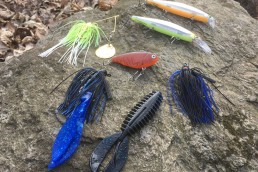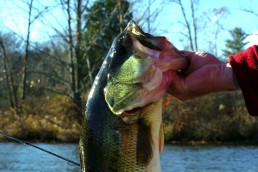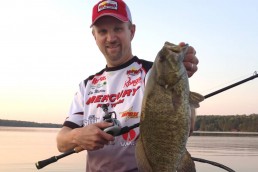Rigging up Right for the Bass of Springtime
SHARE THIS POST
After the long cold winter in the Midwest where many anglers have been watching fishing on TV, bought more tackle, new rods and reels and have dreamt about their first fishing trip of the year, it’s now time to rig up those rods and get ready to tangle with your first bass of the year.
Bass fishing in the spring can be a boom or bust scenario depending on the weather and water temperatures. When I get ready to head out for my first trip of the year, there are five lures I’ll have rigged up, as they all are proven fish-catchers, but more importantly, they can be retrieved differently to coincide with the activity level of the fish.
Fishing a lipless crankbait is a great way to cover water quickly and catch pre-spawn bass. Fishing this lure on wing dams, riprap banks and flats trigger violent strikes from these fat pre-spawn fish. If your lure gets hung on a weed, be ready for a strike, as many times a bass will hit as your lure comes free.
There are many models of the lipless crankbaits on the market, all of which have a different profile in the water both in their shape and the sound or vibration they emit. So, experimenting with baits is very important until you find the one the bass are just choking down. I’ve also found it’s hard to go away from red craw- or chrome/shad-patterned baits.
Numerous times anglers have issues with losing bass on rattle baits because it is easy for bass to throw the lure. I combat this by using a Witch Doctor Tackle Surman 50G Rod with medium-heavy power and at a medium-fast action, as this half- fiberglass, half-graphite rod will load up when a bass inhales your bait, thus increasing your hook-up percentage. And then it will give when the bass makes a run, keeping those treble hooks from tearing out of its mouth. I’ll then spool up a Wright & McGill Victory II Baitcast Reel with 15-pound-test Seaguar Rippin’ Monofilament line. This also aids in increasing my hook-ups and landing ratio of bass with a big lipless crankbait in their mouths. If I’m looking to burn my bait back to the boat I’ll use the high-speed retrieve reel, but if the bass want the bait just crawled along the bottom, just moving fast enough to put off some vibration, I’ll use the lower-speed gear ratio reel.
Suspending jerkbaits have developed into many angler’s go-to lures during the cold-water periods during the spring. This is based on the fact that you can fish them numerous ways while keeping your baits in the “effective” strike zone for an extended period of time, a key element for trigging a sluggish bass into biting.
There are several ways to fish jerkbaits. And all have a time and a place to help you put more bass in the boat. One way is to cast it out (let it sink if it’s a suspending) and just deadstick the bait and then slowly reel it in and deadstick it again. Depending on the water temperatures and prevailing weather, the bass, although hungry, may be sluggish and a jerkbait just sitting there will tempt them into biting.
The second and more exciting way to fish a jerkbait is to cast it out and work the bait back to the boat by giving your rod a quick jerk. This method requires you to experiment and see exactly what the bass want in terms of how hard a jerk, how many jerks in a row you make and how long of a pause you give your bait. Once you dial in your jerkbait presentation to them on that day, the feeling of jerk-jerk-pause, and then wam will be etched in your memory for years to come.
Are you enjoying this post?
You can be among the first to get the latest info on where to go, what to use and how to use it!
My favorite jerkbait the past two years is the Rapala Shadow Rap, as its unique slow side-to-side sway and vertical fade when paused just calls the bass in. This has become one of my go-to baits when targeting this species in extremely cold water or when other baits have bombarded them recently.
I like to use the Witch Doctor Tackle Voodoo (VDC70P3) Rod, as its medium power and moderate-fast action will allow me to toss jerkbaits of all sizes. The unique Witch Doctor Tackle transitional graphite blank provides me with a lightweight rod that allows me to impart the needed action to the jerkbait I’m throwing. I’ll pair that rod with a Wright & McGill Victory II Casting Reel that I’ll spool up with Seaguar TATSU Fluorocarbon. If I want to achieve greater depths or a more subtle presentation with my bait I’ll use 12-pound-test. If I want to keep my bait up in the water column or fish around heavier cover, I’ll use 15-pound line.
The spinnerbait is a tried and true lure for coaxing springtime bass into biting. Depending on water clarity, I will throw a single Colorado blade spinnerbait when the water is more stained. The single Colorado blade puts off a lot of vibration for the bass to key in on when the clarity is poor. If the water is cleaner, I’ll go with a tandem blade combination with a Colorado and willow-leaf blade on the front.
I like to fish spinnerbaits in areas that have emergent vegetation or laydowns. Fishing a spinnerbait across flats where bass could be staging to or spawning is also a good pattern to pursue. As for colors and size, War Eagle Spinnerbaits all the way from 1/4 to 1/2 ounce are frequently tied on the end of my line and allows me to either burn the bait back to the boat or slow- roll it along the bottom, again, depending on the activity levels of the fish. As for colors, I’ll either go with a white or white/chartreuse color pattern.
Flipping a jig will allow you to target bass that are deep or shallow and holding near a wide variety of cover. Depending on the depth, I’ll use a 3/8-, 1/2- or 3/4-ounce jig, as I want it to achieve the desired fall rate to trigger bass into biting. More times than not, I’ll either use a black/blue or green-pumpkin jig to target these holding on points or inside turns before they move up to spawn. As the bass move up shallow, I can then flip that same jig around shallow cover such as boat docks and stumps.
If I’m not flipping a jig, I’ll be for sure flipping a Texas-rigged soft plastic. Again, a green-pumpkin or black/blue plastic gets the nod from me, and is usually some form of a creature bait.
Once the water temperatures are close to 60 degrees, a swimming jig is my lure of choice. At that point, those bass are active and casting a swim jig around emergent vegetation or shallow flats is a great way to put a lot in the boat. Again, use a black/blue color combination, but sometimes a swim jig in a craw or an early-season panfish pattern works.
Paying attention to my ScoutLook Weather App aids me in seeing what days this spring the weather is setting up best for a day on the water, but also helps me in putting together a pattern. By paying attention to this app and seeing what direction and speed the wind is coming, I can then see how the bass are setting up on a bank or flat, especially in how it relates to the wind, meaning, knowing if the area holding the fish has warm water and bait blown into it or is it on the calm side of the lake.
MWO
SHARE THIS POST
Did you enjoy this post?
You can be among the first to get the latest info on where to go, what to use and how to use it!
Glenn Walker
Glenn Walker has been fishing Minnesota and Mississippi River tournaments for more than 15 years, spreading his passion and knowledge of the sport via articles and videos. For more information, check out glennwalkerfishing.com or on Facebook @GlennWalkerFishing.



